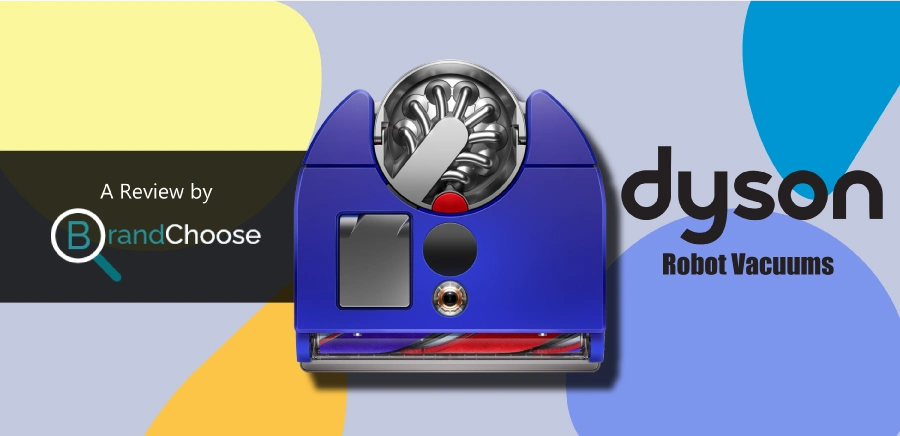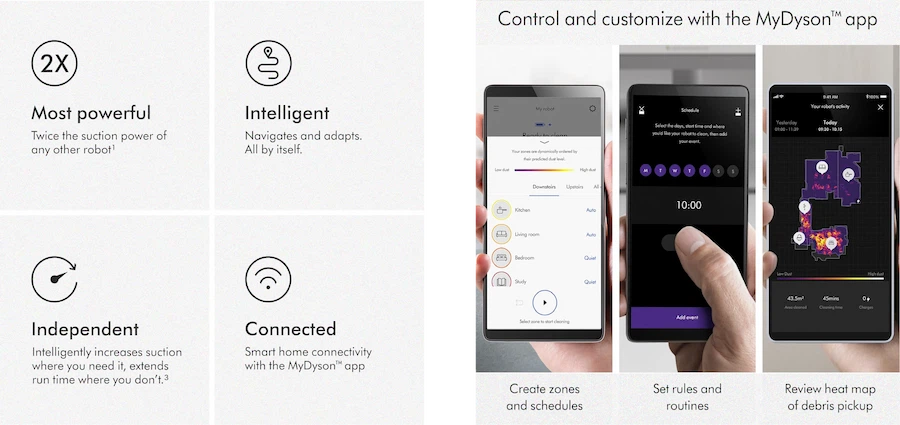Highlights
Dyson Hyperdymium™ Motor – Spins at up to 110,000 rpm for ultra-powerful suction
Radial Root Cyclone™ Technology – Captures fine dust, no loss of suction
360° Vision System – Real-time panoramic mapping
MyDyson™ App – Control, schedule and performance tracking
Full-Width Brush Bar – Edge-to-edge cleaning across all floor types

Dyson isn’t one to quietly join a category—it barges in with something radically different.
Known for redefining the upright vacuum and making airflow a design centerpiece, Dyson’s robotic lineup follows the same playbook. Models like the Dyson 360 Heurist and the ultra-sleek 360 Vis Nav™ turn heads not just with their futuristic, circular look but with powerful performance that can rival corded vacuums. Yes, the brand’s robotic vacuum roster is small—but that’s because Dyson doesn’t do "good enough." These machines are built for deep-clean enthusiasts who want power-packed engineering in a design-first package.
Affordability
3.6 /5
Let’s get the sticker shock out of the way: Dyson robots sit comfortably near the $1,000 line.
That’s flagship territory. You’re not paying for a long list of smart gimmicks—instead, your money goes toward Dyson’s class-leading suction and thoughtful mechanical design. If you’re already in the Dyson ecosystem or care more about clean floors than controlling your vacuum with a voice command, the premium makes sense.
Build Quality & Durability
5.0 /5
Few robot vacuums feel this rock solid. The 360 Vis Nav™ is a tank in a tuxedo—Dyson’s famously over-engineered approach shines through in the thick plastics, tight construction, and robust components. The top-mounted bin is a clever touch for both looks and accessibility, and the full-width brush underneath gives the unit a low profile while maximizing contact across the floor. This is the kind of bot that’ll still be running after others have tapped out.
Smart Features, Innovation & Technologies
3.7 /5
If you’re chasing seamless voice assistants or ultra-connected smart homes, look elsewhere. Dyson takes a more focused approach. The MyDyson™ app gives you detailed cleaning reports, suction level control, and zone scheduling—all in a clean, intuitive layout. It won’t blow you away with flashy extras, but what it does, it does well.
This is more about control and feedback than automation bells and whistles.

Motor & Cleaning Power
4.9 /5
Here’s where Dyson flexes its engineering muscle. The Hyperdymium™ motor, spinning at a wild 110,000 RPM, delivers suction power that puts most robot vacuums—and some uprights—to shame. Their signature cyclone technology, Radial Root Cyclone™ Technology, ensures constant airflow, maintaining performance even as the bin fills. Add in a full-width brush bar that stretches edge to edge, and you’ve got a deep-clean machine that thrives on thick carpets and pet fur.

Navigation & Mapping Technology
4.5 /5
Instead of the usual LiDAR (which uses spinning lasers to scan the environment), Dyson opts for a 360-degree vision system—a camera mounted on top that captures a panoramic view of your space in real time. It’s great in well-lit areas and allows for precise room mapping, multi-zone scheduling, and cleaning logs.

But like most vision-based systems, it can struggle a bit in low light or on shiny floors. Still, the mapping is accurate and the pathing feels intentional—not the random zig-zags you see in cheaper bots.
Docking Station System
3.0 /5
Here’s where Dyson feels behind the curve. The charging dock is sleek and simple—but that’s about it. No auto-empty, no mop pad washing, no fancy multi-function base. You’ll need to empty the bin manually, though its top placement makes that easy. While the dock does the basic job, in a world of robot vacuums with self-cleaning stations, Dyson’s minimalist approach feels a bit too… minimalist.
Obstacle Avoidance & Object Recognition
4.2 /5
There’s no AI-driven object recognition or 3D obstacle sensing here, but the 360-degree camera does help the bot see and avoid most large obstacles. And thanks to its tank-like treads, it’s surprisingly agile—able to climb thresholds, pivot on tight angles, and handle furniture legs with ease. It does miss the occasional sock or power cable, so it’s not foolproof, but it navigates most homes better than you'd expect from a camera-only setup.
Battery Life & Coverage Area
3.5 /5
If there’s a weak spot, it’s the runtime. The 360 Vis Nav™ offers about 75–90 minutes per charge, which is below average for its class. That said, its powerful suction and efficient navigation mean it gets more done per minute than many longer-lasting competitors. It’s better suited to smaller homes, apartments, or segmented cleaning routines. Thankfully, it will return to dock and auto-resume when the battery runs low—no babysitting needed.
Who Should Buy This?
Go with a Dyson robotic vacuum if you are:
• A Dyson loyalist who already trusts their upright or cordless stick vacs
• Looking for deep carpet cleaning & the strongest suction available in a robot
• A design-conscious buyer who loves futuristic aesthetics & top-tier build quality
• A user with smaller living spaces where shorter battery life isn’t a dealbreaker
• A pet owner dealing with lots of embedded hair or fine dust in carpet fibers
Conclusion
Dyson’s robotic vacuums are less about gadgetry and more about guts. They aren’t the smartest bots on the market, but when it comes to raw cleaning strength and standout design, they remain in a class of their own. Ideal for design-forward users or Dyson die-hards who expect deep carpet cleaning with every pass.


